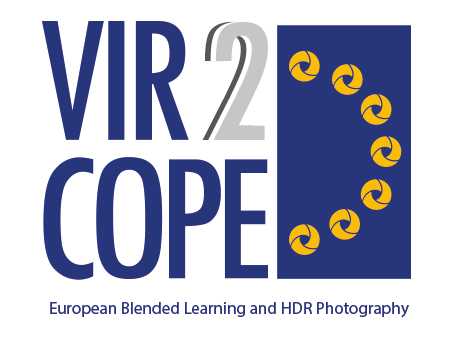

The Vir2Cope Project is a cross-sectoral project within the European Programme "ERASMUS+". Thus, the project partners are from different education sectors or provide different kinds of education: Higher Education, Further Education and Adult Education.
The project deliver an example of best practice for the internationalisation of education by using transnational Blended Learning efficiently. The object of learning is HDR (High Dynamic Range Photography). Most important is the inclusion of webinars as a type of webbased E-learning: Webinars are a tool to contribute to the internationalisation of education and growing use of digital/blended learning.
The ERASMUS+ programme has a strong emphasis on the internationalisation of education. Webinars provide a possibility of realtime webbased communication of groups composed of persons from any country of the world. They can meet in the virtual classroom/conferencing room. The inclusion of transnational webinars can have a strong impact on the internationalisation and modernisation of every type of education providers. Moreover the improvement of learning methods/pedagogy by the application of blended learning in different fields of education as well as the intensivation of cross border cooperation between different education providers will contribute enormously to the cross-sectoral creation of a true European area of skills and qualifications.
"The ERASMUS+ programme aims at promoting equity and inclusion by facilitating the access to learners with disadvantaged backgrounds and fewer opportunities compared to their peers". For webinars the learners do not have to come to a university or other institution. They can just sit at home and participate online. This will enable persons with physical disabilities or people from remote or rural areas to participate in education.
The implementation of blended learning on the european level will be practically done by working on the topic of HDR-photography. This topic has a huge range of target groups in all education sectors, is very creative and inspirating for communication. Additionally working with photography is an excellent intercultural bridge. The HDR-photography itself is a rather new, highly efficient technique for digital photography, which got known more since the last 5 years. Those, being able to use HDR technique in photography, will never go without this technique because of it's highly impressive efficiency compared with conventional photography. For an HDR photo a subject is photographed several times with special camera settings and different exposure times. Finally from several photos is one HDR-photo composed through a computer programme. An HDR-photo can show a huge range of contrasts. It is not only a way to produce very realistic photos (e.g. relevant in documentation, journalism), but it provides also a very high artistical and creative potential to modify photos. In order to compose and process an HDR picture, several free and commercial software programmes are on the market. Recognizing the potential, the industry even starts to equip cameras with HDR tools.
NEED for more Online-Trainers:
There is a lack of knowledge and skills to conduct realtime online trainings/conferences in the field of education. Teaching staff as well as learners are still sceptical and reserved against this powerful communication tool especially for groups. Concerning webinars in ALL field of education, there is a lack of learning opportunities and online teachers for webinars as well. Many learners do not know how online trainings function and often they are afraid, thinking they have not enough digital skills to participate. The participation in webinars is very easy. This message must be convincingly transferred.
NEED to improve and disseminate HDR-Photography:
The processing of HDR-photography as well as its artistical possibilities are by far not developed sufficiently. It is necessary to discuss the features, tools, methods and efficiency of the software for processing HDR images.
Still there is a lack of knowledge about HDR technique, a lack of skills about the HDR technique and a lack of learning opportunities for HDR in Europe. More fields of application of HDR-photography can be find out through the project by the different approaches of the project-partners, e.g. their artistical approach, journalism, graphic design, tourism and by their different target groups like adult and further education, students, elder people, pupils, working people and research.
-------------------------------------------------------------------------------------
Discuss with us in our Facebook Group "Vir2Cope" about the topics of the project.
![]()